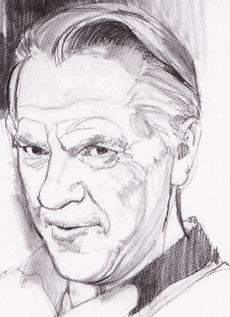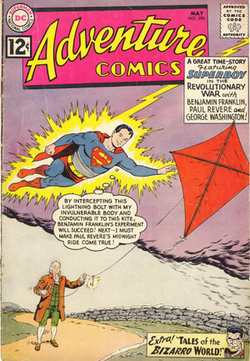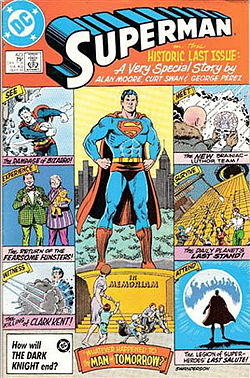- Curt Swan
-
Curt Swan 
Portrait of Curt Swan by Stan DrakeBorn Douglas Curtis Swan
February 17, 1920
Willmar, MinnesotaDied June 17, 1996 (aged 76)
Wilton, ConnecticutNationality American Area(s) Penciller Notable works Action Comics
Adventure Comics
SupermanAwards Inkpot Award, 1984
Will Eisner Award Hall of Fame, 1997Douglas Curtis Swan (February 17, 1920, in Willmar, Minnesota - June 17, 1996)[1] was an American comic book artist. The artist most associated with Superman during the period fans and historians call the Silver Age of comic books, Swan produced hundreds of covers and stories from the 1950s through the 1980s.
Contents
Biography
Early life and career
Curt Swan, whose Swedish grandmother had shortened the original family name of Swanson, was the youngest of five children. Father John Swan worked for the railroads; mother Leotine Hanson had worked in a local hospital.[2] As a boy, Swan's given name — Douglas — was shortened to "Doug," and, disliking the phonetic similarity to "Dog," Swan thereafter reversed the order of his given names and went by "Curtis Douglas," rather than "Douglas Curtis."[3]
Having enlisted in Minnesota's National Guard's 135th Regiment, 34th Division in 1940, Swan was sent to Europe when the "federalized" division was shipped initially to Northern Ireland and Scotland. While his comrades in the 34th eventually went into combat in North Africa and Italy, Swan spent most of World War II working as an artist for the G.I. magazine Stars and Stripes. During this period he also married the former Helene Brickley, who he had met at a dance at Fort Dix, New Jersey, and who was stationed near him in Paris in 1944 as a Red Cross worker.[2] Shortly after returning to civilian life in 1945 he moved from Minnesota to New Jersey and began working for DC Comics.[2] Apart from a few months of night classes (at the Pratt Institute)[2] under the G.I. Bill, Swan was an entirely self-taught artist.[4] After a stint on Boy Commandos he began to just pencil pages, leaving the inking to others.
Superman
Initially, Swan drew many different features, including "Tommy Tomorrow" and "Gangbusters", but slowly he began gravitating towards the Superman line of books. His first job pencilling the iconic character was for Superman #51 (March–April 1948).[5] Many comics of the 1940s and 1950s lacked contributor credits, but research shows that Swan began pencilling the Superboy comic book with its fifth issue in 1949.[4] Swan always felt, however, that his breakthrough came when he was assigned the art duties on Superman's Pal, Jimmy Olsen, in 1954.[4]
It wasn't all smooth sailing, as Swan at first didn't take to line editor Mort Weisinger's controlling style.[2] Swan discussed this period in an interview: "I was getting terrible migraine headaches and had these verbal battles with Mort. So it was emotional, physical. It just drained me and I thought I'd better get out of here before I go whacko." After leaving comics for the advertising world in 1951, Swan soon returned, for National's higher paychecks. And as biographer Zeno notes, "The headaches went away after [Swan] gained Weisinger's respect by standing up to him." There were other times when Swan got frustrated at DC, and years later Marvel Comics attempted to lure him to their company, but he stayed loyal to DC, as their benefits were good and the work was steady.[4]
Around 1954, Swan unsuccessfully pitched an original comic strip for newspaper syndication. Called Yellow Hair, it was about a blond boy raised by Native Americans.[4] A couple of years later, starting with the episode of June 18, 1956, Swan drew the Superman daily newspaper comic strip, which he continued on until November 12, 1960.[4]
Over the years, Swan was a remarkably consistent and prolific artist, often illustrating two or more titles per month.
Later life and career
After DC's 1985 12-issue limited series Crisis on Infinite Earths and with the impending 1986 revision of Superman by writer/artist John Byrne, Swan was released from his duties on the Superman comics. Critic Wallace Harrington summed up Swan's dismissal this way:
“ . . . the most striking thing that DC did was to completely turn their back on the one man that had defined Superman for three decades. . . . They closed the door and turned out the lights on the creator that had defined their whole line. With no real thanks, no pomp nor circumstance, DC simply relieved Curt of his artistic duties on Superman. Curt Swan who had drawn Superman in Action, Lois Lane, Jimmy Olsen, Superman, and World's Finest, and drew Superboy in Adventure Comics, who was the quintessential Superman artist of the 1960s, '70s and '80s. He became was just another victim of the 1980's implosion. Gone.[6] ” Swan's swan song on Superman was the non-canonical 1986 story "Whatever Happened to the Man of Tomorrow?", written by Alan Moore.
After this, Swan continued to do occasional minor projects for DC, including an Aquaman limited series and special in 1989, and various returns on illustrating Superman. Unfortunately, he had not planned well for retirement, and needed to keep working to survive. His marriage dissolved, in some ways due to a recurring drinking problem.[2] Swan's last published story was five pages published posthumously in the 1996 special Superman: The Wedding Album.
Swan was living in Wilton, Connecticut, at the time of his death. He was survived by his former wife Helene, daughters Karen and Cecilia, and son Christopher.[2]
Bibliography
Interior pencil art includes:
DC
Superman #51 (March–April 1948)
Art style
Swan's artwork on Superman was a contrast to Wayne Boring, his Golden Age predecessor.[2] Critic Arlen Schumer praises Swan's ability to depict "the spectrum of human emotion, from agony to anger, mournful to mirthful."[4] As characterized by critic Paul Gravett, Swan's Superman made ". . . Krypton's last son in exile, the alien in our midst, into someone like us, who would think and feel as well as act, who was approachable, big-hearted, considerate, maybe physically superpowerful yet gentle, noble yet subtly tragic."[5] In a similar vein, Swan biographer Eddy Zeno calls Swan "the Norman Rockwell of . . . comics."[4]
With his frequent inker Murphy Anderson from 1970–1974 (and then again from 1988–1989), the pair's collaborative artwork came to be called "Swanderson" by the fans.[5] (Despite his and Anderson's success together, however, Swan's favorite inker was Al Williamson, with whom he only worked a short time, from 1985–1986.)[4]
Legacy
In 1985, DC Comics named Swan as one of the honorees in the company's 50th anniversary publication Fifty Who Made DC Great.[7]
Swan's favorite story — one of the few he both pencilled and inked — was "I Flew With Superman" from Superman Annual #9 (1983), in which Swan himself appears and helps Superman solve a case.[4]
In a story titled "Swan's Way," issue #92 of the Legion of Super-heroes (May 1997) memorialized Swan with a cameo appearance as an art teacher.
In the Superman-based television show Smallville (TV Series), Christopher Reeve made a guest-appearance in two episodes as character Dr. Virgil Swann, who knows all about Kal-El and his origins. This was an allusion to Swan.[citation needed]
Mark Hamill's character "Don Swan" in Comic Book: The Movie is likely a tribute to Swan.
Quotes
Dennis O'Neil:
“ "Swan was the best, a quiet man and not much noticed and consequently underrated because he never caused a fuss; he simply delivered anything an editor asked for, met any challenge and did it with the reliability of the tides."[2] ” Wallace Harrington:
“ When it came time for Warner Brothers to do a decent film of Superman, it was Swan's figure that Christopher Reeve emulated. It was that grace, that strength, that humanity that Swan brought to the character. When asked whether he had a 'model' for his Superman, he said that he was a combination of many things. Part Johnny Weismuller, part Raymond "Rip" Kirby and part George Reeves, 'although I didn't want him to look exactly like Reeves, even though I got a profile or two correct. . . . I drew him to look like a nice guy, someone you'd want on your side.' . . . When Clark looked at you and winked, it was as if he were letting you in on the big joke that no one in the story could see except you and him. Swan made Superman come to life for the reader.[2] ” “ We were both philosophical products of the message we spent a career delivering to the hero-worshippers of the world. We both believed in truth, justice and the American way: a personal torah. It was good finally to learn that we had so much in common when finally we gave each other the space to reveal it.[4] ” “ I'd like to have asked him how much [Swan] identified with Superman, how much of himself he put in there. I feel that he probably did on some private level; that there was some sort of a moral strength that he aspired to, that he drew into those figures. Something almost indefinable, but some essence of himself.[4] ” References
- ^ Curt Swan, Social Security Death Index details, FamilySearch gives June 17, 1996, as the date of death, and was verified by a family member; verification date can be the same as the death date, or one or more days afterward.
- ^ a b c d e f g h i j Harrington, Wallace. Curt Swan, Superman Super Site. Accessed March 28, 2009.
- ^ Swan's former wife Helene, in Zeno, Eddy. Curt Swan: A Life in Comics (Vanguard Productions, 2002). ISBN 1-887591-40-0
- ^ a b c d e f g h i j k l Zeno, Eddy. Curt Swan: A Life In Comics (Vanguard Productions, 2002).
- ^ a b c Gravett, Paul. "Curt Swan: A Superman Walked Among Us". Comic Book Marketplace (2002). Accessed March 28, 2009.
- ^ Harrington, Wallace. "Commentary: A Fine Way to Say Thank You", Superman Home Page. Accessed March 28, 2009.
- ^ Marx, Barry, Cavalieri, Joey and Hill, Thomas (w), Petruccio, Steven (a), Marx, Barry (ed). "Curt Swan The Definitive Superman Realized" Fifty Who Made DC Great: 27 (1985), DC Comics
External links
- Curt Swan at the Grand Comics Database
- Curt Swan at the Comic Book DB
- Curt Swan at Lambiek's Comiclopedia
- Swan, Curt. "Drawing Superman", Superman Through the Ages (1986)
- Curt Swan, Superman Home Page
- Broertjes, Harry. "Curt Swan, 1920–1996", Interlac (August 1996)
- Nightwing of Kandor, "Curt Swan!", Confessions of a Superman Fan
- Reed, Bill. (July 22, 2007) "365 Reasons to Love Comics: #203", Comics Should be Good, Comic Book Resources
- Curt Swan at Vanguard [1]
- Hogan, Billy. "Curt Swan: I Flew With Superman!", Superman Fan Podcast #61 (February 19, 2009)
- Hughes, Bob. "Who Inked Curt Swan on Superman", Who's Whose in the DC Universe?
- Kimball, Kirk. "Super Artist Curt Swan!", Dial B for Blog #231
- Gravett, Paul. "Curt Swan: A Superman walked among Us"
Preceded by
Wayne BoringAction Comics penciller
1967–1986Succeeded by
Kurt SchaffenbergerPreceded by
Al PlastinoSuperman penciller
1968–1986Succeeded by
Jerry OrdwayPreceded by
John ByrneAction Comics penciller
1988–1989Succeeded by
George PérezCategories:- 1920 births
- 1996 deaths
- American comics artists
- American Presbyterians
- American military personnel of World War II
- People from Minneapolis, Minnesota
- People from Willmar, Minnesota
- People from Wilton, Connecticut
- Will Eisner Award Hall of Fame inductees
Wikimedia Foundation. 2010.


